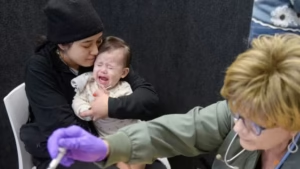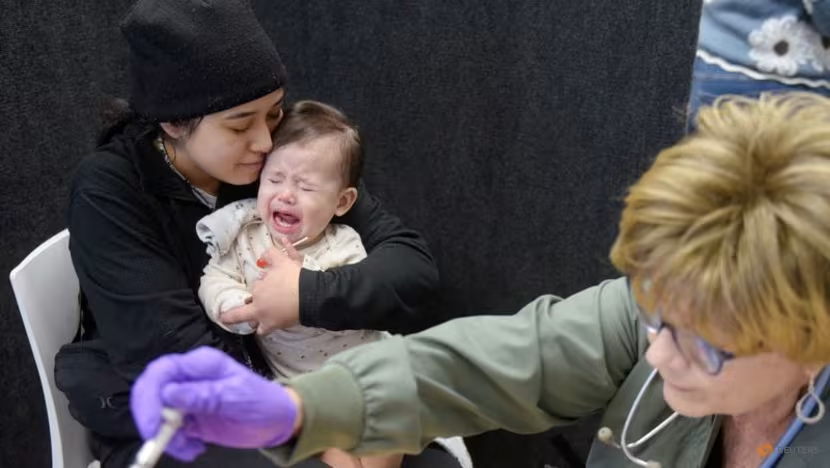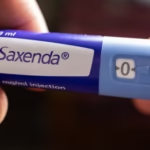Measles, widely recognized as the most contagious disease known to humankind, is witnessing a troubling resurgence across the globe. Public health experts view this comeback as a stark warning, often referring to measles as the “canary in the coal mine” for public health systems.

The return of this vaccine-preventable illness underscores faltering immunization efforts and highlights vulnerabilities in global health security.
A Growing Global Threat
Recent data paints an alarming picture of measles’ return. As of Friday, May 9, the United States reported 1,001 confirmed measles cases and three deaths in 2025, a dramatic increase compared to just 285 cases and no deaths throughout the entirety of 2024. Having been declared free of endemic measles transmission by the World Health Organization (WHO) in 2000, the US is now at risk of losing this critical status by 2026 if the current trajectory persists.
Europe is also experiencing a significant rise, with nearly 6,000 measles cases reported to the European Centre for Disease Prevention and Control this year. Closer to Southeast Asia, the WHO Western Pacific Region recorded 2,584 confirmed cases in the first three months of 2025 alone, a 50 percent increase from the same period in 2024.
Ongoing spread has been reported in Cambodia, Laos, Malaysia, the Philippines, and Vietnam, highlighting regional challenges, even as Brunei and Singapore successfully eliminated the disease in 2015 and 2018, respectively.
Understanding Measles: Highly Contagious and Dangerous
Measles is caused by a virus that spreads easily through the air via respiratory droplets from coughing or sneezing. Its extreme contagiousness is what makes it a critical indicator for public health surveillance.
A single infected person can transmit the virus to between 12 and 18 susceptible individuals in a non-immune population. This makes it roughly twice as contagious as chickenpox and significantly more transmissible than common illnesses like COVID-19 or influenza.
Initial symptoms often resemble a cold, including a high fever, runny nose, cough, and red, watery eyes (conjunctivitis), sometimes accompanied by tiny white spots inside the mouth (Koplik spots). A characteristic red, blotchy rash typically appears a few days later, starting on the face and spreading downwards.
While often perceived as a mild childhood illness, measles can lead to serious, potentially life-threatening complications. These include ear infections, severe diarrhea and dehydration, bronchitis, laryngitis, pneumonia (a common cause of death in young children), encephalitis (brain inflammation that can cause convulsions, deafness, or intellectual disability), and even blindness.
Pregnant women who contract measles face risks of miscarriage or premature birth. In 2023, the WHO estimated that over 100,000 people, predominantly children under the age of five, died worldwide from measles. Even in high-income countries with advanced healthcare systems, the death rate remains concerning, at about one in every 1,000 cases.
The Preventable Tragedy: Factors Fuelling the Resurgence
The current surge in measles cases is largely a preventable tragedy, driven by a dangerous convergence of factors, many stemming from the unintended consequences and legacies of the COVID-19 pandemic.
Most critically, routine childhood immunization rates experienced a significant decline across many countries. Pandemic-related disruptions led to missed vaccination appointments, and essential immunization services were slow to fully recover in the aftermath. This created widening immunity gaps in populations.
Simultaneously, vaccine hesitancy has unfortunately risen, fueled by the systematic proliferation of dis- and misinformation, particularly rampant across social media platforms. This has deepened public distrust in public health institutions and vaccination programs. High-profile figures expressing lukewarm support for measles vaccination or promoting unproven treatments further exacerbate this issue, notably observed in the ongoing US outbreak where almost all cases have occurred in unvaccinated individuals.
The Importance of Herd Immunity: Protecting the Vulnerable
Due to its extreme contagiousness, achieving herd immunity against measles requires very high population vaccination rates – typically at least 95 percent with two doses of the Measles, Mumps, and Rubella (MMR) vaccine.
Herd immunity protects individuals who cannot be vaccinated, such as infants too young to receive the vaccine, those with specific medical contraindications or allergies, and individuals with severely weakened immune systems who cannot receive live vaccines like the MMR.
Even a slight drop below the 95 percent threshold creates pockets of susceptible individuals where the virus can easily spread, leading to outbreaks. The presence of measles cases within a community often serves as an early warning sign of broader weaknesses in immunization programs, potentially paving the way for other vaccine-preventable diseases to re-emerge.
A Looming Crisis: Challenges to Global Surveillance and Aid
Public health professionals warn that the global measles crisis is likely to worsen in the near future, exacerbated by critical challenges to international aid and surveillance efforts. The United States has historically been a cornerstone of global immunization initiatives through both bilateral and multilateral aid channels.
However, recent decisions, such as the cancellation of a billion-dollar grant to Gavi, the Vaccine Alliance, by the Trump administration in March, create significant funding gaps. Gavi, a vital public-private partnership, has been instrumental in increasing vaccine access in low- and middle-income countries, contributing to the vaccination of over 1 billion children worldwide.
Equally concerning is the uncertain future of the Global Measles and Rubella Laboratory Network, coordinated by the WHO. This network comprises over 760 laboratories in more than 150 countries and is essential for global measles surveillance, tracking the virus’s spread and genetic changes. With the US acting as its sole funder, a potential US withdrawal from the WHO would significantly cripple this critical surveillance infrastructure.
Implications for Countries Like Singapore: Not Immune to Global Trends
Even countries with high vaccination rates, like Singapore, which boasts close to 97 percent coverage for at least one dose of the MMR vaccine among children, are not immune to the global measles situation. While theoretically capable of preventing sustained local spread, the rise in global cases increases the frequency of imported measles cases into Singapore.
Vulnerable populations remain at risk. Infants under one year old are particularly susceptible as they are too young to receive their first MMR dose under the current National Childhood Immunisation Schedule.
Additionally, individuals who received only a single dose of the vaccine or adults vaccinated decades ago may experience waning immunity over time, leaving them less protected. Increased travel, both by residents going overseas and visitors arriving in Singapore, raises the risk of exposure and potential localized outbreaks, particularly in high-contact settings like infant care centers.
Singapore’s Communicable Disease Agency has already reported eight imported measles cases since the start of 2025, underscoring this ongoing risk.
Reversing the Trend: Investment in Prevention
Addressing this dangerous global trend requires concerted effort. While filling the void left by recent international aid cuts is challenging, countries with established expertise and resources, such as Singapore, can play a crucial role. Increasing contributions to regional vaccination efforts and outbreak response capabilities through bilateral partnerships or existing regional mechanisms like ASEAN and the WHO Regional Office are vital steps.
Such investments should not be viewed merely as diplomatic gestures or financial drains but as strategic and effective measures for national public health protection, reducing the risk of measles and other communicable diseases crossing borders.
Measles vaccination is recognized as one of the “best buys” in public health interventions due to its extraordinary return on investment. For every dollar spent on measles vaccination, countries are estimated to receive up to US$58 in economic and social benefits, ranging from reduced healthcare costs associated with treating measles cases and complications to increased productivity from individuals who avoid illness. Few public health interventions deliver such significant returns.
Continuing to ensure high vaccination rates remains paramount for Singapore, alongside maintaining vigilance for imported cases. This necessitates robust efforts to counter vaccine misinformation and address hesitancy proactively. It is crucial to challenge misconceptions spread by anti-vaccine activism, unequivocally stating that measles is not a mild childhood illness and that the MMR vaccine is safe and not linked to autism – a claim based on a thoroughly debunked fraudulent study.
Ultimately, the measles resurgence is a critical test of public health system strength and resilience. The proverbial canary in the coal mine is issuing a clear warning against complacency, emphasizing that even countries that have achieved elimination must remain vigilant and actively contribute to global efforts to control this highly contagious disease.








